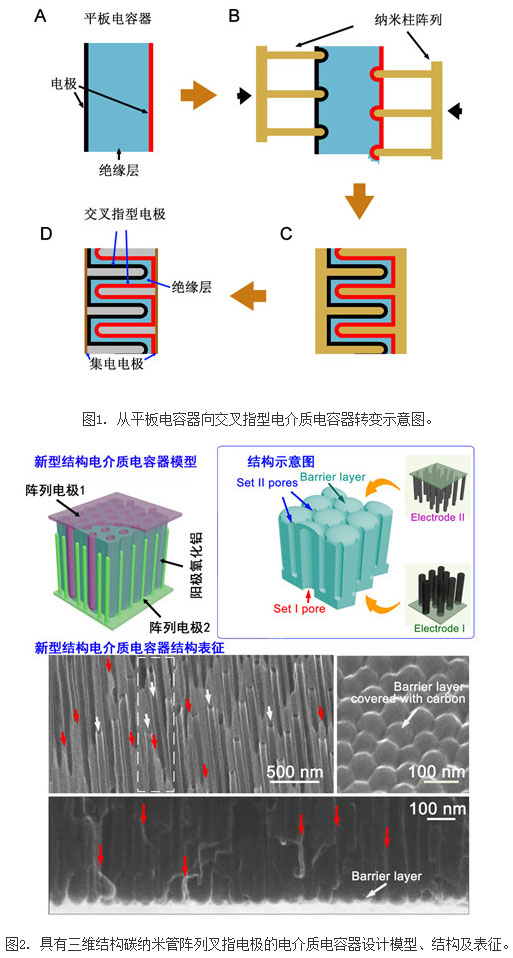
Recently, the Meng Guowen Research Group of the Institute of Solid State Physics of the Chinese Academy of Sciences' Hefei Institute of Physical Science collaborated with Professor Song Li, a professor at the University of Science and Technology of China, and Wei Bingqing, a professor at the University of Delaware in the United States, to design a dielectric capacitor with a three-dimensional structure of interdigitated nanoelectrodes. Related research results are published in Science Advances (Sci. Adv. 2015, 1, e1500605) headed by Dielectric capacitors with three-dimensional nanoscale interdigital electrodes for energy storage. Dielectric capacitors are "containers" that store electric charge and can provide energy for various electrical devices. Compared with batteries, dielectric capacitors have high power density and can provide tremendous power in an instant. However, the charge of the dielectric capacitor is only stored at the surface of the electrode, so the general dielectric capacitor has a poor charge storage capability (low energy density), which is also a bottleneck restricting the practical application of the dielectric capacitor. Increasing the specific surface area of ​​the electrode material can improve the ability of the dielectric capacitor to store charge. For this reason, nanoporous materials are commonly used as electrode materials to improve their ability to store charge. However, using an ordinary nanostructure as an electrode, it is difficult to significantly increase the storage capacity of the dielectric capacitor.
Recently, Institute of Solids researchers collaborated with Song Li and Wei Bingqing to skillfully design a dielectric capacitor with a three-dimensional structure of interdigitated nanoelectrodes. Their design ideas are shown in FIG. 1. FIG. 1A shows an ordinary flat plate capacitor in which two pairs of nanopillar arrays are relatively inserted from two flat plates of a capacitor, as shown in FIG. 1B. In this process, assuming that the two electrode plates and the dielectric layer in between can both supply material without breaking, the three-dimensional structure interdigitated electrodes can be finally formed with the insertion of two pairs of nano-pillar arrays. 1C) Then, after removing the nanopillar array, a dielectric capacitor with interdigitated electrodes is formed (FIG. 1D). In the same macroscopic (apparent) electrode area, the actual specific surface area will be greatly increased, which will greatly increase the charge storage capacity.
In order to prepare a dielectric capacitor with a three-dimensional structure of interdigitated nanoelectrodes (as shown in Figure 2), researchers used high-purity aluminum as raw material, followed by conventional anodization, followed by rapid anodization with high current, and finally from porous alumina. The back side of the film is controlled to be etched to obtain an aluminum oxide film having an interdigitated pore structure on both sides (as shown in FIG. 2). This type of alumina film contains two sets of pores that are parallel to each other and have opposite opening directions, and two Group holes are isolated from each other and are not interconnected. Then, the carbon nanotube array was grown in the two sets of holes of this kind of interdigitated hole alumina film, and a dielectric capacitor of this novel structure was obtained (Fig. 2). In such a capacitor, a porous alumina film having a high dielectric constant serves as a dielectric layer, and two sets of interdigitated carbon nanotubes are two counter electrodes.
The new structure of the dielectric capacitor, the two pairs of electrodes have a large specific surface area, can effectively store a lot of charge; dielectric layer is formed by the anodized aluminum spontaneous thickness of the hole wall and the arc-shaped barrier layer, to ensure The capacitor has a very high breakdown voltage. These favorable factors are superimposed to greatly increase the charge storage capacity of the dielectric capacitor. The test found that the energy density of the capacitor can reach 2Wh/kg, which is the highest value of all the current reports. This new type of structured dielectric capacitor is expected as a power source or a hybrid power source for high power or related fields requiring higher energy density. Related research results have been published by Science Advances, and have been published by EurekAlert!, a global scientific news service under the American Association for the Advancement of Science (AAAS), the United States’ Daily Science, and Phys. Org. The international science and technology network was reported as a highlight of the study.
This work was supported by the "973 Program" of the Ministry of Science and Technology, the "Innovation Team International Partner Program" of the Chinese Academy of Sciences / the State Bureau of Foreign Experts, the National Natural Science Foundation of China, and the Natural Science Foundation of Anhui Province.
Sliding Gate Track,Sliding Gate Track Kits,Sliding Gate Wheels And Track,Sliding Gate Rail Track
Jiaxing Gates Hardware Products Co.,Ltd , https://www.888gates.com
